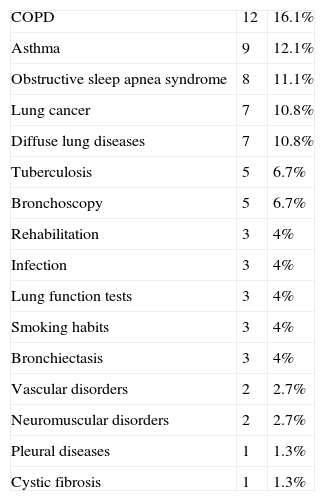The Portuguese Journal of Pulmonology (PJP) is committed to cover all kinds of topics related to respiratory physiology and pathology. There are, in fact, several respiratory journals, which are associated with a specific group of diseases or even with some diagnostic and therapeutic procedures. However the PJP, as a Portuguese Pulmonology Society (SPP) Journal, has necessarily to consider all the issues and special situations related to all respiratory disorders and to showcase the variety of Portuguese research in this area. In addition there is the increasing contribution of publications from different international researchers, who find PJP a reliable instrument for publishing their data.
In the last three years, PJP has significantly modified its editorial procedures1 and has achieved an increasingly high profile internationally as shown by the evolution of its impact factor and so we have felt that it was important to carry out a re-evaluation of the data published, especially of original papers, in order to find out whether there was an emphasis on particular lung disorders or predominant diagnostic or therapeutic issues.
Although this overview is only about the papers that have been published, it does not include papers submitted which for several reasons had not completed the editorial process, we can confirm that a great variety of topics has been considered by PJP (Table 1). However, some disorders stand out from the rest; COPD with 16.1% of all the published articles, obstructive sleep apnea syndrome with 10.8% and asthma with 12.1%, are the most prevalent topics addressed.2–4 This is not surprising, since obstructive lung diseases are traditionally the leading respiratory disorders that attract most attention and interest from the majority of the SPP members. Apart from these, obstructive sleep apnea syndrome has been recognized as one of the most dynamic issues in the respiratory field and there is an increasing volume of published data; certainly a significant number of papers published in PJP are related to the various national groups working in research in this area. More surprising is the number of papers related to diffuse lung diseases, a topic that is not usually considered a priority by the majority of national researchers, but this fits in with what is happening in international respiratory journals in general. In contrast to this there have only been a small number of contributions from researchers involved in respiratory physiology, which was a popular topic in the past, as any study of previous editions will testify; along with important data which had a significant impact in the international literature. On the other hand, pulmonary vascular disorders which have recently undergone impressive pharmacological development and are associated with a flourish of research published in the main respiratory journals, was the focus of only two papers, both from international researchers. Likewise, pleural disease, an issue usually considered with great interest by the most lung physicians was the subject of only one paper. 5
.
| COPD | 12 | 16.1% |
| Asthma | 9 | 12.1% |
| Obstructive sleep apnea syndrome | 8 | 11.1% |
| Lung cancer | 7 | 10.8% |
| Diffuse lung diseases | 7 | 10.8% |
| Tuberculosis | 5 | 6.7% |
| Bronchoscopy | 5 | 6.7% |
| Rehabilitation | 3 | 4% |
| Infection | 3 | 4% |
| Lung function tests | 3 | 4% |
| Smoking habits | 3 | 4% |
| Bronchiectasis | 3 | 4% |
| Vascular disorders | 2 | 2.7% |
| Neuromuscular disorders | 2 | 2.7% |
| Pleural diseases | 1 | 1.3% |
| Cystic fibrosis | 1 | 1.3% |
In conclusion, despite some discrepancies, PJP seems to have fulfilled its role as a journal which is open and alert to the diversity of topics involved in the research of respiratory disorders.
Please cite this article as: Morais A. A Revista Portuguesa de Pneumologia como um jornal aberto à diversidade da investigação respiratória. Rev Port Pneumol. 2014;20:285–6.







